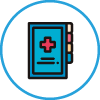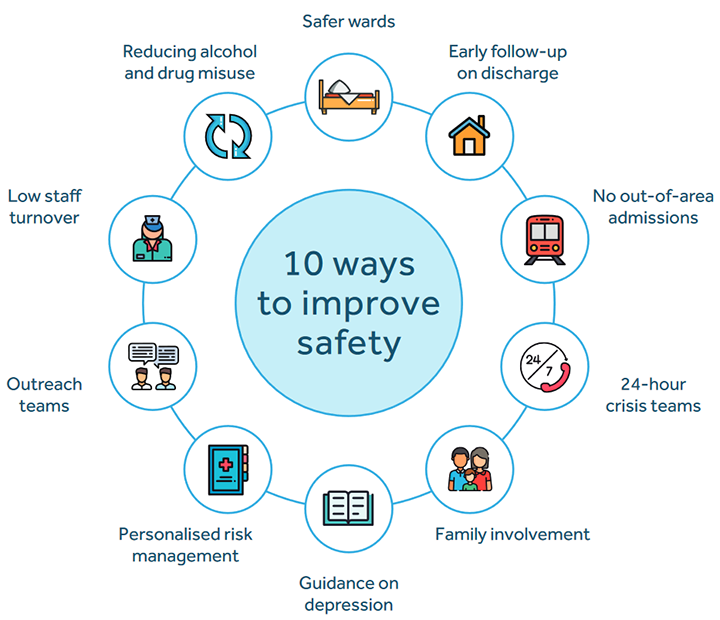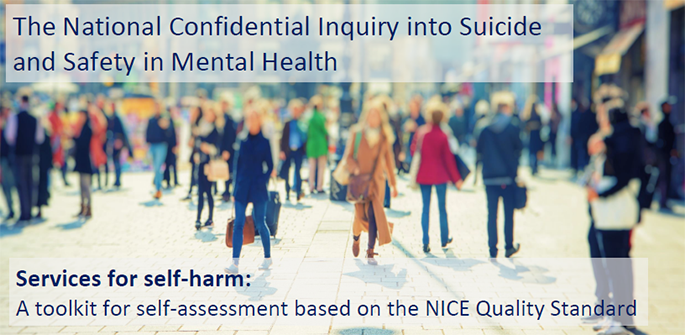Annual report 2024
Findings relating to people who died by suicide in 2011-2021 in the UK.
Suicide by people in contact with drug and alcohol services
10th NCISH Virtual Conference
7th May 2024, 10am-1pm.
The National Confidential Inquiry into Suicide and Safety in Mental Health (NCISH) is an internationally unique project.
Our study has collected in-depth information on all suicides in the UK since 1996. Our recommendations have improved patient safety in mental health settings and reduced patient suicide rates, contributing to an overall reduction in suicide in the UK. Our evidence is cited in national policies and clinical guidance and regulation in all UK countries.
Due to overriding public interest in improving safety in clinical services, the National Data Opt-Out (where a person chooses not to have their health data shared for reasons beyond treatment and care) does not apply to data we collect.
Improving safety in mental health services
We have been collecting data for over 20 years. Based on our evidence from studies of mental health services, primary care and accident and emergency departments we have developed a list of 10 key elements for safer care for patients.
These recommendations have been shown to reduce suicide rates.
Safer wards
 Services should review in-patient safety, and remove potential ligature points from wards. There should be measures in place to prevent patients from leaving the ward without staff agreement; this might be through better monitoring of ward entry and exit points, and by improving the in-patient experience through recreation, privacy and comfort. Observation policies should recognise that observation is a skilled intervention to be carried out by experienced staff and should recognise that suicide risk is increased within the first week of admission.
Services should review in-patient safety, and remove potential ligature points from wards. There should be measures in place to prevent patients from leaving the ward without staff agreement; this might be through better monitoring of ward entry and exit points, and by improving the in-patient experience through recreation, privacy and comfort. Observation policies should recognise that observation is a skilled intervention to be carried out by experienced staff and should recognise that suicide risk is increased within the first week of admission.
Our evidence
Following NCISH recommendations, suicide using non-collapsible ligature points became an NHS ‘never event’ (a serious incident that is preventable) in 2009. This means that health services are required to monitor their incidence, and are provided with advice to reduce the risk.
Since then suicide by mental health in-patients has fallen by 42%, although the number of in-patient suicides in 2018-2021 have not fallen; there were an estimated 74 suicides by in-patients in the UK (excluding Northern Ireland) in 2021. Between 2011 and 2021, over a third of in-patient suicides took place on the ward. Half of in-patients who died by suicide were on agreed leave. Over a quarter were under enhanced nursing observation. In our study of clinicians’ views of good quality practice in mental healthcare, clinicians emphasised practices that improved safety in a ward environment such as observations conducted by trained staff.
Guidance
This recommendation was originally cited in the Department of Health report An Organisation with a Memory in 2000.
More recently, it is included in:
Early follow-up on discharge
 Patients discharged from psychiatric in-patient care should be followed up by the service within 72 hours of discharge. A comprehensive care plan should be in place at the time of discharge and during pre-discharge leave.
Patients discharged from psychiatric in-patient care should be followed up by the service within 72 hours of discharge. A comprehensive care plan should be in place at the time of discharge and during pre-discharge leave.
Our evidence
In the UK, there were 2,389 suicides within three months of discharge from in-patient care between 2011 and 2021. 14% of these post-discharge suicides occurred within the first weeks of leaving hospital, with the highest number occurring on day 3 after leaving hospital (day 1 = day of discharge, 18%).
Guidance
We have recommended all patients are followed up within 72 hours of discharge from in-patient care. The NICE guidance of following up all discharged patients within 7 days was formally reviewed as part of the NHS Commissioning for Quality and Innovation (CQUIN) 2019/20 scheme. Based on our findings, the time frame has since been reduced to 72 hours. NHS England has included 72 hour follow-up in the NHS Standard Contract 2022/23.
The 72-hour follow-up standard is also cited in HM Government’s Suicide prevention strategy for England: 2023-2028.
National clinical guidelines have been developed with reference to our findings on suicide following discharge from in-patient care. See the NICE guidance on transition between in-patient mental health settings and community or care settings.
In 2021/2022 NHS England will continue the 2020/2021 winter funding programme to improve the care of post-discharge patients in England.
No out-of-area admissions
 Very ill patients should be accommodated in a local in-patient unit. Being admitted locally means that patients stay close to home and the support of their friends and family, and are less likely to feel isolated or to experience delayed recovery. Local admission should also result in simpler discharge care planning.
Very ill patients should be accommodated in a local in-patient unit. Being admitted locally means that patients stay close to home and the support of their friends and family, and are less likely to feel isolated or to experience delayed recovery. Local admission should also result in simpler discharge care planning.
Our evidence
In the UK, 213 patients (10% of post-discharge deaths) died after being discharged from a non-local in-patient unit. In 2021 there were 19 suicides after discharge from a non-local unit. There has been a downward trend in the number of suicides by patients recently discharged from hospital in the UK. There were an estimated 193 post-discharge deaths in 2021, down from a peak of 299 in 2011.
Guidance
Both the King’s Fund Under Pressure report and the Independent Commission on Acute Adult Psychiatric Care referenced this recommendation in 2015, calling for an end to acute admissions out of area.
National clinical guidelines have been developed with reference to our findings on suicide following discharge from in-patient care. See the NICE guidance on transition between in-patient mental health settings and community or care settings.
24-hour crisis resolution/home treatment teams
 Community mental health services should include a 24-hour crisis resolution/home treatment team (CRHT) with sufficiently experienced staff and staffing levels. CRHTs provide intensive support in the community to patients who are experiencing crisis, as an alternative to in-patient care. CRHT teams should be monitored to ensure that they are being used safely. Contact time within CRHTs should reflect the specialist and intensive nature of that role.
Community mental health services should include a 24-hour crisis resolution/home treatment team (CRHT) with sufficiently experienced staff and staffing levels. CRHTs provide intensive support in the community to patients who are experiencing crisis, as an alternative to in-patient care. CRHT teams should be monitored to ensure that they are being used safely. Contact time within CRHTs should reflect the specialist and intensive nature of that role.
Our evidence
The setting where suicide prevention can have the greatest impact is the crisis team; the main location where patients with acute illness are now seen. In England, there are on average 184 suicides per year by CRHT patients – over two times as many as under in-patient services. The introduction of a 24-hour CRHT appears to add to the safety of a service overall, with a reduction in suicide rates in implementing mental health services. In our study of the assessment of clinical risk in mental health services, both patients and carers emphasised the need for clarity about what to do and who to contact in a crisis.
Guidance
Actions to improve crisis support are outlined in the NHS Long-Term Plan and the Suicide prevention strategy for England: 2023-2028, including expanding all-age mental health crisis services across NHS trusts, in partnership with wider partners such as voluntary, community and social enterprise (VSCE) organisations, to support current demand.
Family involvement
 Working more closely with families could improve suicide prevention. Services should consult with families from first contact, throughout the care pathway and when preparing plans for hospital discharge and crisis plans.
Working more closely with families could improve suicide prevention. Services should consult with families from first contact, throughout the care pathway and when preparing plans for hospital discharge and crisis plans.
Staff should also make it easier for families to pass on concerns about suicide risk and be prepared to share their own concerns. This could help to ensure there is a better understanding of the patient’s history and what is important to them in terms of their recovery, and may support better compliance with treatment.
There should be a multi-disciplinary review following all suicide deaths, involving input from and sharing information with families.
Our evidence
Staff told us that greater involvement of the family by the service would have reduced suicide risk in 18% of patients.
One example of clinicians think services can improve contact with families is by informing them when a patient does not attend an appointment. In only 27% of deaths by suicide the service contacted the family when the patient missed the final appointment before the suicide occurred. Policies for multidisciplinary review and information sharing with families were associated with a 24% fall in suicide rates in implementing NHS Trusts, indicative of a learning or training effect.
Patients tell us they want their families to have as much involvement as possible in their assessment of clinical risk, including sharing crisis/safety plans with them. Clinicians tell us family involvement is vital to enhancing patient safety in mental healthcare settings.
Guidance
The Independent Commission on Acute Adult Psychiatric Care cite these recommendations, stating that families and carers are an underused resource.
An in-depth thematic review of claims made after an individual has attempted to take their life by NHS Resolution recommends family members and carers are included in all serious incident investigations following a suicide death.
The NICE Quality Statement on suicide prevention and the NICE guideline on self-harm state individuals presenting with suicidal thoughts or plans, or individuals who have self-harmed, should have the opportunity to discuss whether they would like their family, carers or friends involved in their care.
Guidance on depression
 There should be a local NHS Trust/Health Board policy based on NICE (or equivalent) guidelines for depression and self-harm.
There should be a local NHS Trust/Health Board policy based on NICE (or equivalent) guidelines for depression and self-harm.
Our evidence
Across the UK, suicide by patients with affective disorder (including bipolar disorder) and depression has generally been falling since 2012, with an average of 647 deaths per year between 2011 and 2021. Services that implemented NICE guidance for depression and self-harm guidelines had significant reductions in suicide rates of 26% and 23% respectively.
Guidance
See the NICE Quality Standard for the Management of Self-harm and the NICE guideline on self-harm: assessment, management and preventing recurrence.
See the NICE guidelines on the identification and management of depression in children and young people and the NICE guidelines on depression in adults: treatment and management.
Personalised risk management
 All patients’ management plans should be based on the assessment of individual risk and not on the completion of a checklist. Patients should have the opportunity to discuss with their mental health team the signs that they will need additional support, such as specific stresses in their life (e.g. economic adversity, experience or threat of domestic violence), anniversaries and dates that are important to them and online experience. Families and carers should have as much involvement as possible in the assessment process, including the opportunity to express their views on potential risk. Consulting with the patient’s GP may also be helpful.
All patients’ management plans should be based on the assessment of individual risk and not on the completion of a checklist. Patients should have the opportunity to discuss with their mental health team the signs that they will need additional support, such as specific stresses in their life (e.g. economic adversity, experience or threat of domestic violence), anniversaries and dates that are important to them and online experience. Families and carers should have as much involvement as possible in the assessment process, including the opportunity to express their views on potential risk. Consulting with the patient’s GP may also be helpful.
Risk assessment is one part of a whole system approach that should aim to strengthen the standards of care for everyone, ensuring that supervision, delegation and referral pathways are all managed safely.
Our evidence
Most risk assessment tools seek to predict future suicidal behaviour. Clinicians tell us that tools, if they are used, should be simple, accessible, and considered part of a wider assessment process. Treatment decisions should not be determined by a score. Risk tools and scales have a positive predictive value of less than 5%, meaning that they are wrong 95% of the time, and miss suicide deaths in the large ‘low risk’ group. In a sample of patient suicides, the quality of assessment of risks and management was considered by clinicians to be unsatisfactory in 36%.
In our study of suicide risk assessment in UK mental health services, we found risk is often individual, suggesting the management of risk should be personal and individualised.
Guidance
NICE guidelines on the assessment, management and preventing recurrence of self-harm state that risk assessment tools should not be used to predict future suicide or repetition of self-harm, or to determine who should or should not be offered treatment. The guidelines suggest risk assessment should focus on the person’s needs and how to support their immediate and long-term psychological and physical safety. These guidelines are also referred to in the Suicide prevention strategy for England: 2023-2028.
The use of risk assessment tools in mental health services has been debated in Parliament.
Outreach teams
 Community mental health teams should include an outreach service that provides intensive support to patients who are difficult to engage or who may lose contact with traditional services. This might be patients who don’t regularly take their prescribed medication or who are missing their appointments.
Community mental health teams should include an outreach service that provides intensive support to patients who are difficult to engage or who may lose contact with traditional services. This might be patients who don’t regularly take their prescribed medication or who are missing their appointments.
Our evidence
Implementation of an assertive outreach policy was associated with lower suicide rates among patients who were non-adherent with medication or who had missed their last appointment with services, and with lower suicide rates overall in implementing Trusts.
In our study of clinicians’ views of good quality practice in mental healthcare, clinicians emphasised dedicated outreach services that provide intensive support to enhance patient engagement.
Guidance
The Independent Commission on Acute Adult Psychiatric Care includes recommendations for comprehensive and effective community mental health, including outreach teams. The Northern Ireland strategy for preventing suicide and self-harm cites this recommendation.
Low staff turnover
 There should be a system in place to monitor and respond to non-medical staff turnover rates. Non-medical staff are all other health staff except doctors.
There should be a system in place to monitor and respond to non-medical staff turnover rates. Non-medical staff are all other health staff except doctors.
Our evidence
Organisations with low turnover of non-medical staff had lower suicide rates than organisations where staff changed frequently. In addition, those services with low staff turnover saw a greater reduction in their suicide rates when they implemented NCISH recommendations than services with high staff turnover.
Guidance
The King’s Fund cited this recommendation in their Under Pressure report in 2015.
Reducing alcohol and drug misuse
 We recommend there are local drug and alcohol services available that work jointly with mental health services for patients with mental illness and alcohol and drug misuse.
We recommend there are local drug and alcohol services available that work jointly with mental health services for patients with mental illness and alcohol and drug misuse.
Other clinical measures that could reduce suicide risk in this group are substance misuse assessment skills in frontline staff and specialist substance misuse clinicians within mental health services. People in contact with both drug and alcohol and mental health services have multiple complex needs. Engaging these people with both mental health and substance misuse interventions is important to suicide prevention.
Our evidence
Across all UK countries, alcohol and drug misuse is common among patients who die by suicide (47% and 38% of all patient suicides UK-wide, respectively, higher in Scotland and Northern Ireland). However, only a minority of patients who died by suicide were in contact with specialist alcohol and drug misuse services. Between October 2021 and September 2022, 428 people in England and Wales died by suicide within 12 months of contact with drug and alcohol services, 8% of all suicide deaths registered in this period.
In England, there was a 25% fall in rates of suicide by patients in those NHS Trusts which had put in place a policy on the management of patients with co-morbid alcohol and drug misuse.
Guidance
See the NICE guidelines on coexisting severe mental illness and substance misuse.
Embedding suicide prevention in drug and alcohol policy and services is an action in the strategy for preventing suicide and self-harm in Northern Ireland.
The Suicide prevention strategy for England: 2023-2028 also highlights plans to identify actions to improve mental health treatment for people with mental health conditions who also misuse alcohol and drugs. This will include improving access to mental health treatment and promoting better links between mental health services and substance misuse treatment services.
Our toolkits
Safer services
Our toolkit presents the 10 key elements as quality and safety statements about clinical and organisational aspects of care. It can be used by mental health care providers as a basis for self-assessment.
![]() Download our Safer Services toolkit (PDF version)
Download our Safer Services toolkit (PDF version)
![]() Download a Word version of our Safer Services toolkit, which can be used to record progress.
Download a Word version of our Safer Services toolkit, which can be used to record progress.
![]() Download a visual representation of our 10 key elements for safer care of patients.
Download a visual representation of our 10 key elements for safer care of patients.
![]() Download an animated video about our 10 ways to improve safety.
Download an animated video about our 10 ways to improve safety.

Toolkit for self-harm
A toolkit for self-assessment based on the NICE Quality Standard for Self-Harm.
![]() Download Services for Self-Harm toolkit (PDF version)
Download Services for Self-Harm toolkit (PDF version)
Information for practitioners
We produce a wide range of national and themed reports and research papers, as well as other resources.
Service users and carers
Share your views and experience on mental health care and your suggestions about how we can develop our work.
Help in a crisis
Sources of help and support can be found on our page for help in a crisis.
Reporting concerns
To report concerns about the care you, or someone else, has received, visit:
Bereavement support
For those bereaved or affected by suicide.

